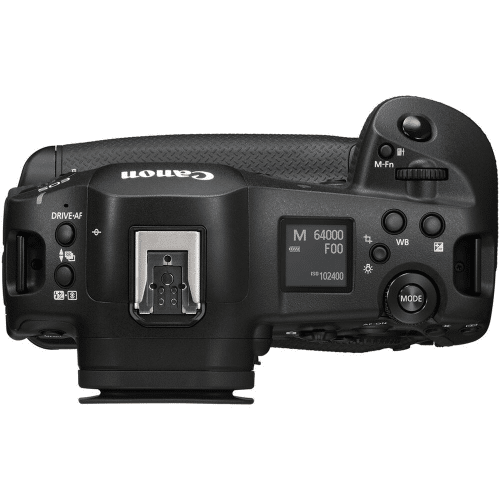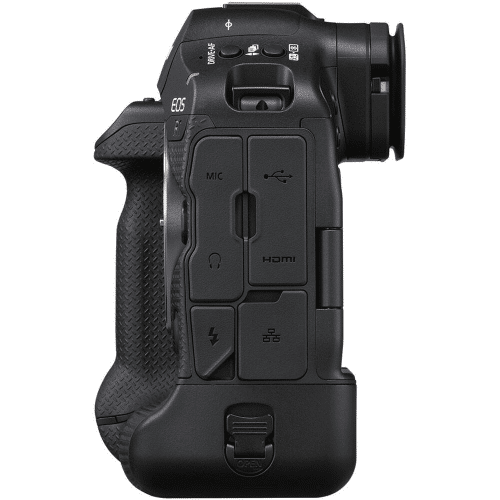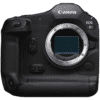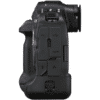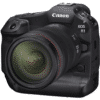CANON EOS R1 MIRRORLESS DIGITAL CAMERA (BODY)
1 in stock
HIGHLIGHTS
24MP Full-Frame Stacked BSI CMOS Sensor
DIGIC Accelerator + DIGIC X Processing
Dual Pixel AF with Action Priority
Improved Eye Control AF
6K 60 Raw & 4K 120 10-Bit Internal Video
Up to 40 fps, Pre-Continuous Shoot Mode
₹592,000.00 ₹630,995.00
Best Buy ₹580,160.00
Free Shipping across India
Have a question? Ask Us Chat | Email | Call
1 in stock
CANON EOS R1 MIRRORLESS DIGITAL CAMERA (BODY)

EOS R1 – The Flagship
Speed, precision, and reliability, the Canon EOS R1 is built for photojournalists, sports photographers, wildlife shooters, and other image-makers who can’t afford to miss the shot. The flagship of the EOS R line, this mirrorless camera sports a full-frame 24MP BSI stacked sensor, DIGIC Accelerator processing, next-gen Dual Pixel Intelligent AF, and the robust design expected from a professional workhorse.
24.2MP Full-Frame Sensor and Continuous Shooting
As a camera built for speed, the R1 sports a newly designed 24.2MP full-frame back-illuminated stacked sensor that offers impressively fast readout speeds and a staggering 40 fps top continuous shooting rate with an electronic shutter, along with blackout-free viewing and greatly reduced rolling shutter distortion. The back-illuminated design and new DIGIC Accelerator processing also help to produce high clarity and sharpness, native sensitivity up to ISO 102400, and utilize Neural Network Noise Reduction for especially clean files when working in low-light conditions.
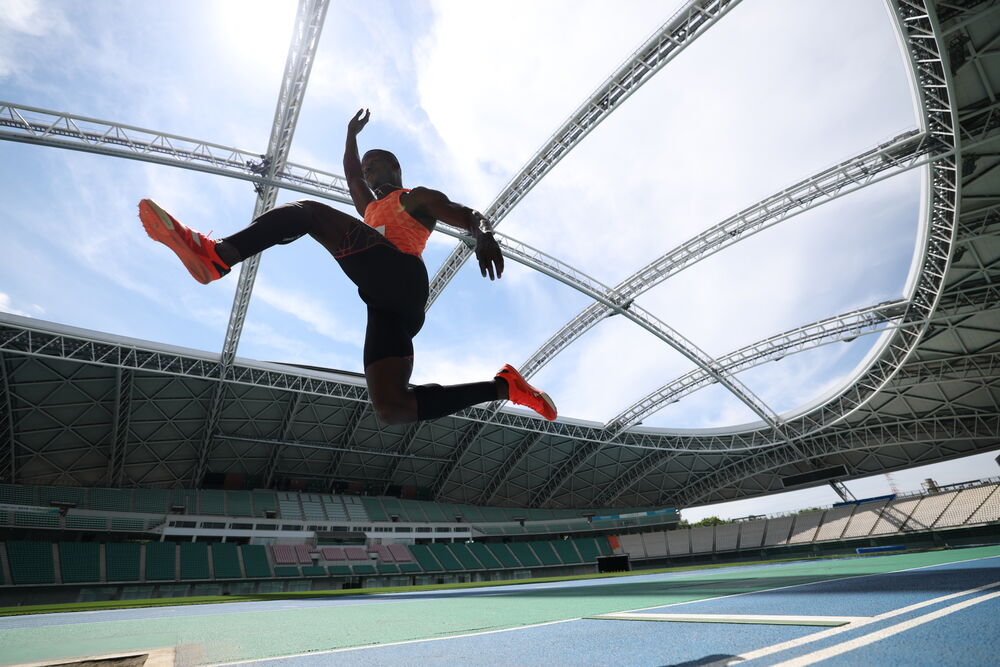
For continuous shooting applications, the 40 fps shooting rate can be used in conjunction with Pre-Continuous Shooting, which allows the camera to continuously pre-buffer 20 frames over a 0.5-second period while half-pressing the shutter, prior to fully pressing the shutter—helping to ensure you never miss the critical moment of action. The EOS R1 also has a mechanical shutter, which supports a top continuous shooting rate of 12 fps.
For instances when 24MP isn’t enough, DIGIC Accelerator processing now enables In-Camera Upscaling, which uses deep learning to double the number of pixels both horizontally and vertically in order to produce a separate 96MP image in about 10 seconds. This upscaling can be done after the original image is shot and can also be performed at the time of cropping images in camera, saving time compared to generating a 96MP image and then cropping it afterward.
One of the critical pieces that enables the EOS R1 to do everything is can do is the newly developed DIGIC Accelerator front-engine processor, which complements a proven DIGIC X processor. The DIGIC Accelerator is responsible for many of the continuous shooting, subject detection and tracking, and autofocus capabilities, allowing the DIGIC X to serve fully as an image processor. The combination of these two distinct processors enables the camera to better process huge volumes of data, perform simultaneous tasks at high speeds, and contributes to the quality and accuracy of deep learning features, like In-Camera Upscaling and Neural network Noise Reduction.
- Auto-Exposure and Auto White Balance Modes use Deep Learning
- 6144-zone exposure metering for high accuracy in various lighting conditions
- Coordinated Image Stabilization pairs IBIS with Lens-Based IS
- Supports Anti-Flicker and High-Frequency Anti-Flicker shooting
Helping keep both photos and video sharp and stable, the EOS R1 uses a well-rounded image stabilization system using three distinct methods: in-body sensor-shift, optical, and an independent Movie Digital IS system purpose-built for video.
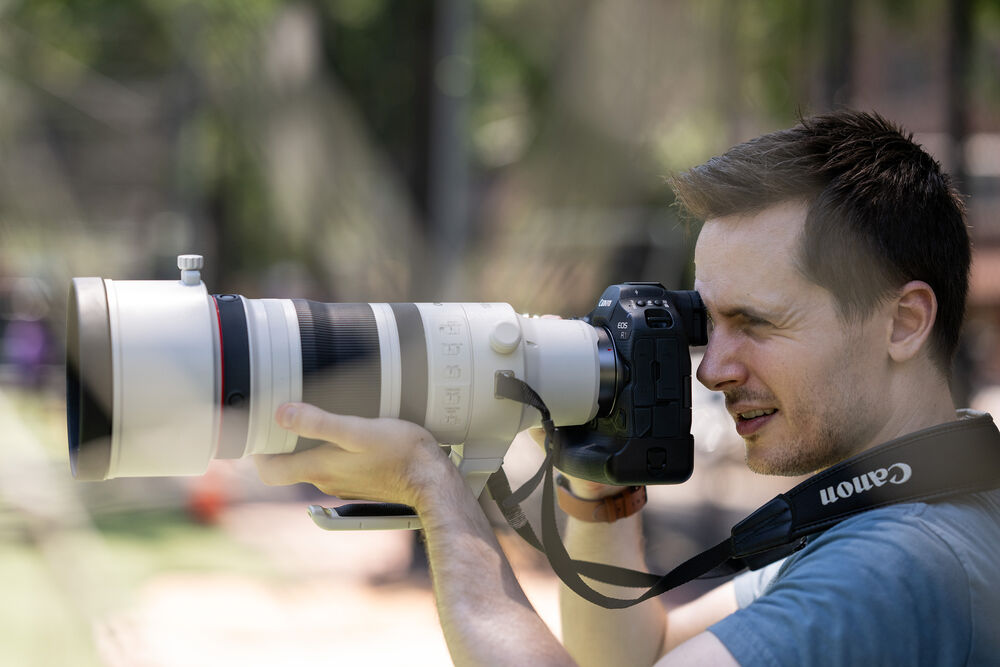
- The camera body’s 5-axis sensor-shift system is compatible with all lenses and helps to lessen the effects of camera shake in a general sense, for sharper handheld shooting at slower shutter speeds.
- When paired with an RF lens with image stabilization, Coordinated Control IS can deliver even more powerful stabilization, up to 8.5 stops of correction in the center of the frame and 7.5 stops of correction at the periphery.
- For video shooters, Movie Digital IS is an electronic stabilization system that helps suppress blur in peripheral areas to better enable recording video handheld.
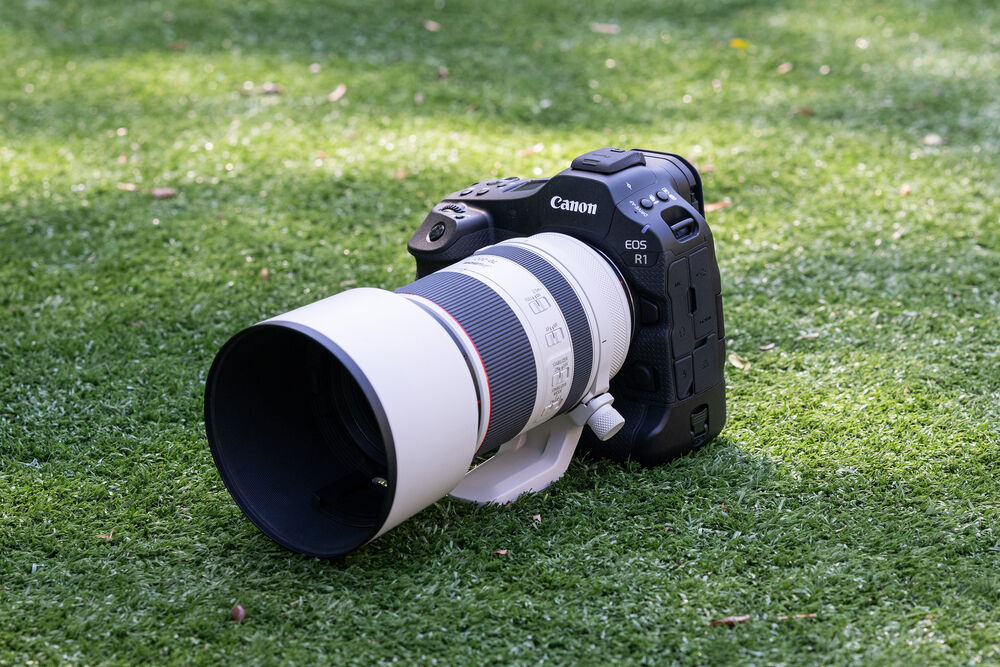

Beyond speed, autofocus performance is the main calling card of a flagship camera. The R1’s AF capabilities have been optimized to detect, track, and maintain critical focus on moving subjects, even when they are briefly obscured while shooting. This Dual Pixel system has been fine-tuned with numerous tracking features and usability assets to make it the most intelligent and intuitive focusing system in an EOS yet.
- The sensor incorporates cross-type Dual Pixel AF for more responsive and accurate focusing performance, especially in scenes with an abundance of linear details, like with window blinds, brick or wooden plank walls, or other patterned backgrounds.
- Focusing is possible down to -7.5 EV for photo and -5.5 EV for video for working in truly low-light conditions.
- The 4897-point phase-detection system can automatically recognize People, Animals (Dogs, Cats, Birds, and Horses), and Vehicles. This system also has Eye Detection, with the ability to prioritize the left or right eye.
One of the main benefits of the DIGIC Accelerator is a new focusing mode built specifically for photographing sports and action: Action Priority. This intelligent AF mode recognizes specific subjects movements and automatically moves the AF area to the player performing a detected motion, such as taking a shot, making a pass, jumping, and more.
It currently recognizes Soccer, Basketball, and Volleyball activities and can analyze Ball, Joint, Torso, Action, and Head information for tracking. The mode can recognize specific subjects and uses this information in conjunction with recognized movements to determine where to focus in the scene while the action is unfolding.
- Action Priority can be assigned to a custom function button for quick on/off toggling.
- Pre-Registered Person Priority allows you to register up to 10 different people in-camera prior to photographing an event; this information is stored and used to prioritize who to focus on while the game or match is being played.
- Intelligent subject recognition also helps to maintain sharp focus on the intended subject even when it’s obscured or crossed by a secondary subject in the frame.
- Can be used in conjunction with Pre-Continuous Shooting mode.
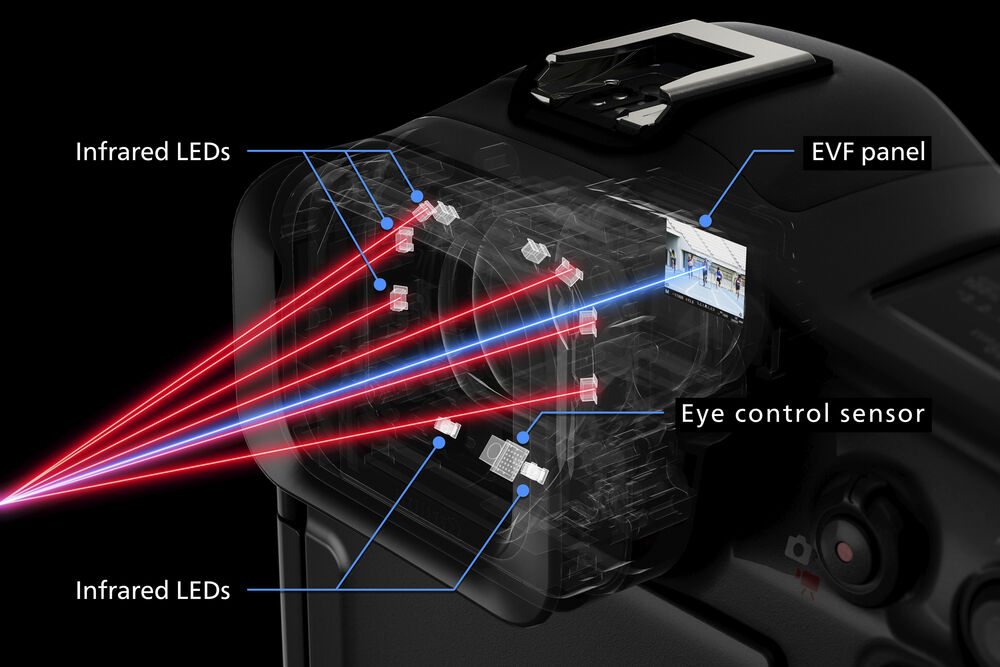
Taken from the EOS R3, the R1 also inherits the unique Eye Control AF method, which allows you to simply look where you want to focus and then have the AF Area automatically move there when you press the AF activation button. The R1 improves upon this tool, though, with 2x faster detection and a revised line-of-sight detection algorithm, as well as greater tolerances for different eyelid thicknesses, eyelash length, how the camera is held, and even if you wear eyeglasses.
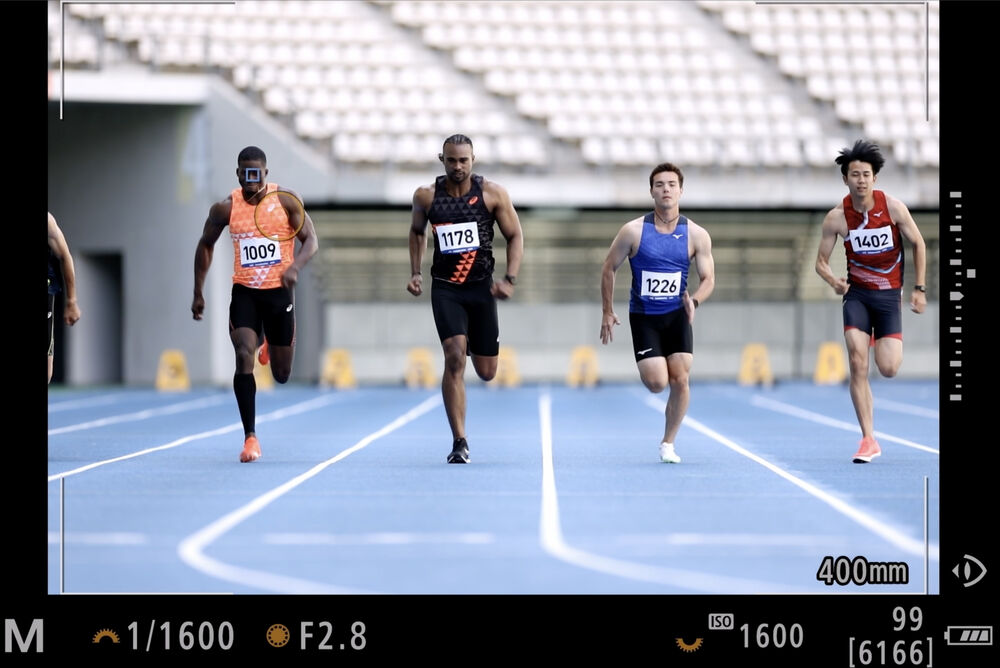
| Brands | Canon |
|---|
CANON EOS R1 MIRRORLESS DIGITAL CAMERA (BODY) SPECIFICATIONS
| Lens Mount |
Canon RF
|
| Sensor Resolution |
Actual: 26.7 Megapixel
Effective: 24.2 Megapixel |
| Image Sensor |
36 x 24 mm (Full-Frame) BSI Stacked CMOS
|
| Image Stabilization |
Sensor-Shift, 5-Axis
|
| ISO Sensitivity Range |
Photo
100 to 102,400 (Extended: 50 to 409,600) |
| Continuous Shooting |
Electronic Shutter
Up to 40 fps at 24.2 MP Mechanical Shutter Up to 12 fps at 24.2 MP |
| Internal Recording Modes |
Raw 12-Bit
6000 x 3164 at 23.98/24.00/25/29.97/50/59.94 fps MP4/XF-AVC S/XF-HEVC S 4:2:2/4:2:0 8/10-Bit DCI 4K (4096 x 2160) at 23.98/24.00/25/29.97/50/59.94/100/120 fps UHD 4K (3840 x 2160) at 23.98/25/29.97/50/59.94/100/120 fps DCI 2K (2048 x 1080) at 23.98/24.00/25/29.97/50/59.94/100/120/200/240 fps 1920 x 1080 at 23.98/25/29.97/50/59.94/100/120/200/240 fps |
| External Recording Modes |
4:2:2 10-Bit via HDMI
DCI 4K (4096 x 2160) at 23.98/24.00/25/29.97/50/59.94 fps UHD 4K (3840 x 2160) at 23.98/25/29.97/50/59.94 fps |
| Media/Memory Card Slot |
Dual Slot: CFexpress Type B (CFexpress 2.0) [VPG-400 or Faster Recommended]
|
| Video I/O |
1x HDMI (Unspecified Signal) Output
|
| Audio I/O |
1x 1/8″ / 3.5 mm TRS Stereo Headphone Output
1x 1/8″ / 3.5 mm TRS Stereo Microphone Input |
| Power I/O |
1x USB-C Input
|
| Other I/O |
1x USB-C (USB 3.2 / 3.1 Gen 2) Control/Data/Tether Input/Output (Shared with Power Input)
1x RJ45 (Ethernet) Data Output |
| Wireless |
2.4 / 5 / 6 GHz Wi-Fi 6 (802.11ax), Bluetooth 5.3 Control
|
| Display Type |
Articulating Touchscreen LCD
|
| Battery Type |
1x LP-E19 Rechargeable Lithium-Ion, 10.8 VDC, 2750 mAh
|
| Lens Mount |
Canon RF
|
| Sensor Resolution |
Actual: 26.7 Megapixel
Effective: 24.2 Megapixel |
| Image Sensor |
36 x 24 mm (Full-Frame) BSI Stacked CMOS
|
| Sensor Crop (35mm Equivalent) |
Crop Factor: 1x
*Additional Crop Occurs in Select Video Modes |
| Image Stabilization |
Sensor-Shift, 5-Axis
|
| Built-In ND Filter |
No
|
| Capture Type |
Stills & Video
|
| Shutter Type |
Mechanical Focal Plane Shutter and Electronic Rolling Shutter
|
| Shutter Speed |
Electronic Shutter
1/64000 to 30 Seconds 1/16000 to 30 Seconds in Manual Mode 1/16000 to 30 Seconds in Shutter Priority Mode Electronic Front Curtain Shutter 1/8000 to 30 Seconds Mechanical Shutter 1/8000 to 30 Seconds |
| Bulb/Time Mode |
Bulb Mode
|
| ISO Sensitivity Range |
Photo
100 to 102,400 (Extended: 50 to 409,600) |
| Metering Method |
Center-Weighted Average, Evaluative, Partial, Spot
|
| Exposure Modes |
Aperture Priority, Manual, Program, Shutter Priority
|
| Exposure Compensation |
-3 to +3 EV (1/3, 1/2 EV Steps)
|
| Metering Range |
-3 to 20 EV
|
| White Balance |
Presets: Auto, Cloudy, Color Temperature, Custom, Daylight, Flash, Fluorescent (White), Shade, Tungsten
|
| Continuous Shooting |
Electronic Shutter
Up to 40 fps at 24.2 MP Mechanical Shutter Up to 12 fps at 24.2 MP |
| Interval Recording |
Yes
|
| Self-Timer |
2/10-Second Delay
|
| Image Sizes |
3:2 HEIF / JPEG / Raw
24.2 MP (6000 x 4000) |
| Aspect Ratio |
3:2
|
| Image File Format |
HEIF, JPEG, Raw
|
| Internal Recording Modes |
Raw 12-Bit
6000 x 3164 at 23.98/24.00/25/29.97/50/59.94 fps MP4/XF-AVC S/XF-HEVC S 4:2:2/4:2:0 8/10-Bit DCI 4K (4096 x 2160) at 23.98/24.00/25/29.97/50/59.94/100/120 fps UHD 4K (3840 x 2160) at 23.98/25/29.97/50/59.94/100/120 fps DCI 2K (2048 x 1080) at 23.98/24.00/25/29.97/50/59.94/100/120/200/240 fps 1920 x 1080 at 23.98/25/29.97/50/59.94/100/120/200/240 fps |
| External Recording Modes |
4:2:2 10-Bit via HDMI
DCI 4K (4096 x 2160) at 23.98/24.00/25/29.97/50/59.94 fps UHD 4K (3840 x 2160) at 23.98/25/29.97/50/59.94 fps |
| Fast-/Slow-Motion Support |
Slow-Motion Only
|
| Gamma Curve |
Canon Log 2, Canon Log 3, HDR-HLG, HDR-PQ, Rec709, Rec2020
|
| Recording Limit |
No
|
| IP Streaming |
No
|
| Built-In Microphone |
Stereo
|
| Audio Recording |
Raw: 4-Channel 24-Bit LPCM Audio
2-Channel 16-Bit AAC Audio |
| Media/Memory Card Slot |
Dual Slot: CFexpress Type B (CFexpress 2.0) [VPG-400 or Faster Recommended]
|
| Video I/O |
1x HDMI (Unspecified Signal) Output
|
| Audio I/O |
1x 1/8″ / 3.5 mm TRS Stereo Headphone Output
1x 1/8″ / 3.5 mm TRS Stereo Microphone Input |
| Power I/O |
1x USB-C Input
|
| Other I/O |
1x USB-C (USB 3.2 / 3.1 Gen 2) Control/Data/Tether Input/Output (Shared with Power Input)
1x RJ45 (Ethernet) Data Output |
| Wireless |
2.4 / 5 / 6 GHz Wi-Fi 6 (802.11ax), Bluetooth 5.3 Control
|
| Mobile App Compatible |
Yes: Android & iOS
App Name: Canon Camera Connect Functionality: Access Stored Files, Adjust Settings, Firmware Update, Remote Control, View Live Feed |
| Global Positioning (GPS, GLONASS, etc.) |
GPS
*Via Connected Smartphone |
| Display Size |
3.2″
|
| Resolution |
2,100,000 Dot
|
| Display Type |
Articulating Touchscreen LCD
|
| Secondary Display |
Top: LCD Status Display
|
| Type |
Built-In Electronic (OLED)
|
| Size |
0.5″
|
| Resolution |
9,440,000 Dot
|
| Eye Point |
25 mm
|
| Coverage |
100%
|
| Magnification |
Approx. 0.9x
|
| Diopter Adjustment |
-4 to +2
|
| Focus Type |
Auto and Manual Focus
|
| Focus Mode |
Continuous-Servo AF, Manual Focus, Single-Servo AF
|
| Autofocus Points |
Photo
Phase Detection: 4897 Video Phase Detection: 4067 |
| Autofocus Sensitivity |
-7.5 to +21 EV
|
| Built-In Flash/Light |
No
|
| Maximum Sync Speed |
1/320 Second
|
| Flash Compensation |
-3 to +3 EV (1/3, 1/2 EV Steps)
|
| Dedicated Flash System |
eTTL
|
| External Flash Connection |
Shoe Mount
|
| Operating Temperature |
32 to 113°F / 0 to 45°C
|
| Operating Humidity |
0 to 85%
|
| Battery Type |
1x LP-E19 Rechargeable Lithium-Ion, 10.8 VDC, 2750 mAh
|
| Shoe Mount |
1x Hot Shoe
|
| Tripod Mounting Thread |
1x 1/4″-20 Female (Bottom)
|
| Material of Construction |
Magnesium Alloy
|
| Dimensions (W x H x D) |
6.2 x 5.9 x 3.4″ / 157.6 x 149.5 x 87.3 mm
|
Shipping Policy
- Free Shipping
- No shipping charges throughout India.
- We deliver throughout India, Monday-Saturdays, excluding India Public holidays.
- We would dispatch the order in 1-2 working days and it should reach to you in minimum 4 days and maximum in 8 working days
- If there is any delay or if the customer has any quarries relating to shipment they can reach to us on 9356372991.



